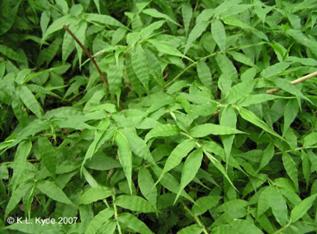A report just out from APHIS/USDA has new answers to questions concerning morphology, dispersal, potential for invasiveness, and reproduction of Wavyleaf Basketgrass. View the USDA’s report >>
Maryland Has Become Ground Zero For A New Invasive Species Threat, Wavyleaf Basketgrass
October 22, 2011: The Baltimore Sun
Asian plant’s sticky, podlike seeds are being unwittingly spread by hikers and pets.
What Triggers Mass Extinctions? Study Shows How Invasive Species Stop New Life
December 2010: Article from Science Daily
http://www.sciencedaily.com/releases/2010/12/101230100050.htm
Potential Origin of Prospective Federal Noxious Weed Identified
2009 Annual Report: Center for Plant Health Science and Technology (CPHST)
CPHST Fort Collins and cooperators at the University of Alabama in Huntsville recently developed a molecular genotyping method to help establish the identity of wavy leaf basket grass (WLBG, Oplismenus hirtellus ssp. undulatifolius), a shade tolerant grass that was recently discovered invading the forest understory in Maryland and aggressively spreading to the state of Virginia. In collaboration with the Smithsonian Institution to search for the origin of WLBG in the U.S., we found that Oplismenus undulatifolius from Caucasus Mountains in Russia (Krasnodarskiy region) was a genetic match to the U.S. invasive WLBG. We will now begin genotyping specimens from China to determine if these are also potential source populations. For questions, please contact Sharon Talley at 970-490-4463.
http://xa.yimg.com/kq/groups/189401/906424619/name/Talley-Experiment-Me
Wavyleaf Basket Grass, an Invasive Exotic, Found in Virginia
November 2009: Virginia Forests, a blog of the Division of Resources Information, Virginia Department of Forestry.
http://virginiaforests.blogspot.com/2008/11/wavyleaf-basket-grass-invasive-exotic.html
Virginia Flora Project News
2008: Project News from the Flora Project of Virginia
Open Letter to Congress: Control of Asiatic Wavyleaf Basketgrass, Oplismenus hirtellus undulatifolius
Friday, February 03, 2012
